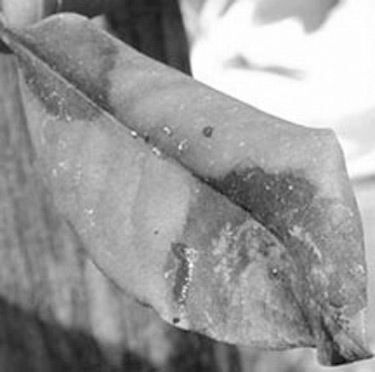JARS v62n2 - Sudden Oak Death Website: A Resource for Updates on a Deadly Disease
Sudden Oak Death Website: A Resource
for Updates on a Deadly Disease
Sonja Nelson
The California Oak Mortality Task Force website at www.suddenoakdeath.org is a good resource for gardeners and professionals who want to stay current on progress being made in the fight against Sudden Oak Death (SOD), caused by Phytophthora ramorum and the related Phytophthora kernoviae . The website gives the history, symptoms, diagnosis, treatment and locations of the disease along with current SOD research.
Website background of the disease: " Phytophthora ramorum is the cause of both Sudden Oak Death, a forest disease that has resulted in widespread dieback of several tree species in California and Oregon forests, and ramorum blight, which affects the leaves and twigs of numerous other plants in forests and nurseries. Since the mid 1990s, P. ramorum has caused substantial mortality in tanoak trees and several oak tree species (coast live oak, California black oak, Shreve oak and canyon live oak), as well as twig and foliar diseases in numerous other plant species, including California bay laurel, Douglas fir, and coast redwood. The pathogen was also discovered in European nurseries in the mid 1990s, and it has since spread to wild land trees in the U.K. and the Netherlands. Although the first trees in the U.K. and the Netherlands. Although the first P. ramorum -infested California nursery stock was identified in 2001 (Santa Cruz County), the U.S. nursery industry was not widely impacted by the disease until 2003, when the pathogen was detected in California, Oregon, Washington, and British Columbia nurseries."
Since the identification of SOD, nurseries, including our rhododendron nurseries, have been under strict regulations to restrict the spread of the disease, and rhododendron purchasers can be generally confident that the plants they purchase are free of SOD. As most ARS members know, rhododendrons and azaleas can be hosts to SOD. Rhododendron and azalea species and hybrids are considered "regulated hosts," which means these plants are "naturally infected by P. ramorum ." The website includes a long list of these regulated hosts.
The website description of Rhododendron spp. infected with SOD: "Leaf spots are the main symptom, though dieback of small branches is seen on plants in Europe. Lesions penetrate through the plant tissue so that spots are identical both on the top and bottom of the leaf. They can be triangular in shape and extend along the leaf mid-vein, or can be found where water collects on the leaf surface (along edges, near the petiole, and at the leaf tip). Leaf spots have diffuse margins and the appearance of watersoaking."

|
In the February 2008 newsletter of the California Oak Mortality Task Force, an item on P. kernoviae highlights the international scope of SOD: "In January 2008, P. kernoviae was found for the first time in Scotland on two rhododendron plants in a private garden. Inspectors with the Scottish Government and Forestry Commission are surveying the rest of the garden and as well as a 3km-wide zone around the outbreak site. All plants found to be infected will be destroyed as well as any host plants within 2 meters of the confirmed plant(s)."
The website lists numerous research reports - too many to list here. However, one will be shown below as an example, in this case the attempt to find a control: DEFRA’s Central Science Laboratory (CSL) has issued their "Investigation of Alternative Eradication Control Methods (Heat Treatment) for P. ramorum and P. kernoviae on/in Plants."
In Brief: Wet and dry heat treatments were investigated for the eradication of P. ramorum and P. kernoviae on Camellia, Rhododendron and Viburnum plants. Initial experiments determined the lethal threshold temperature and exposure times for three isolates of each Phytophthora species using wet (hot water) and dry-heat treatments against mycelium and sporangia.
Overall, wet heat treatments were more effective than dry heat treatments and P. kernoviae was consistently more temperature sensitive than P. ramorum . Mycelia of both Phytophthora species were more sensitive to wet heat treatment than sporangia, whereas sporangia were more sensitive to dry heat treatments than the mycelium.
For a complete history and periodic updates on SOD, explore the California Oak Mortality Task Force website www.suddenoakdeath.org
